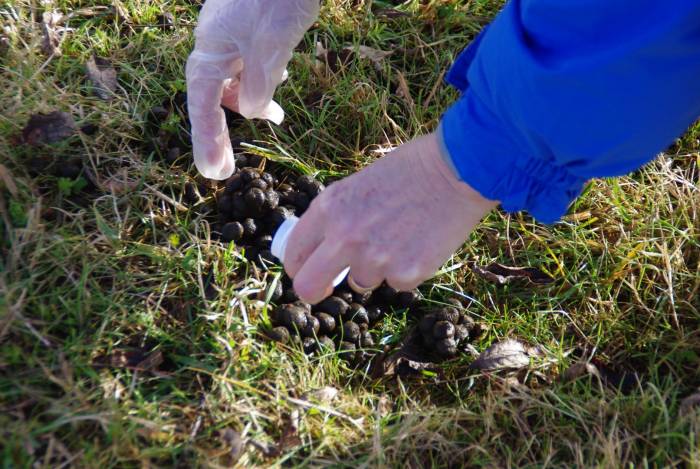Anthelmintic resistance on individual farms is often a complicated picture with no quick test or quick fix. But testing is very important and can be a huge help when putting together worming strategies. Tests vary in terms of their cost, complexity and robustness and are outlined below in terms of this hierarchy, starting with the cheapest and most simple.
- Post-dosing faecal egg count (or drench tests). A quick indication of the efficacy of an anthelmintic can be gauged by laboratory testing faecal samples from 10 sheep following after treatment. The time after treatment depends on the anthelmintic used – it is seven days after 2-LV (yellow), 10-14 days after 1- BZ (white) and 14-16 days after a 3-ML (clear), 4-AD (orange) or 5-SI (purple). In practice, this means checking post treatment either seven days for 2-LV or 14 days for all other products. The test is merely an indicator of anthelmintic inefficacy and not necessarily anthelmintic resistance per se, as many other factors can influence test results. The usefulness of this test is improved if faecal samples from 10 sheep in the dosed group are collected and submitted on the day of dosing, to provide a rough estimate of the reduction in FEC achieved (and to confirm there was a measurable epg before treatment).
- Faecal egg count reduction test (FECRT). A more structured on-farm test can be conducted in which a number of different anthelmintics are tested against a control. For this, 15-20 sheep* are randomly allocated to control or treatment groups (one for each class to be tested) and a pre-treatment FEC taken for each group as the baseline. FECs are then repeated on at least 10 of the control sheep and the 2-LV group (yellow) after seven days, followed by FECs from the control sheep and the 1-BZ (white), 3-ML groups (clear), 4-AD (orange) and 5-SI (purple) after 14 days. Anthelmintic resistance is suspected if the percentage reduction in FEC of a test group compared with the controls is less than 95%. Results may differ according to whether arithmetic or geometric means are used in the calculations. Where necessary, the advice of an expert should be sought with interpretation of the results. In a simplified version of the FECRT, pre-dose FECs are not performed, and results are just based on the percentage reduction in mean FEC in the treatment groups compared to the controls. (*NB. Select sheep that have not been dosed within 30 days, or longer if moxidectin has been previously used. A mean FEC of 200epg or more is recommended before starting the trial.)
- Larval development tests (LDTs) and egg hatch assays (EHAs). A range of in-vitro tests has been developed to avoid the use of animals in testing for resistance. The two most commonly used are the egg hatch assay (EHA) for the 1-BZ (white) anthelmintics, and the larval development test (LDT) for 1-BZ (white) and 2-LV (yellow) classes. There are currently no in-vitro tests yet available for 3-ML (clear) resistance. Farm visits are not necessarily required and the samples can be sent by post direct to the laboratory. However, currently these tests are relatively expensive, precluding their widespread use. Sensitivity is generally considered higher than with the FECRT so anthelmintic resistance may be detected when the frequency of resistant alleles within the worm populations is still low. Interpretation is, however, not straightforward and requires expert input.
Although not reversible, the presence of anthelmintic resistance is dynamic. Detection on a farm will vary according to season, the worm species present at the time a test was applied and the test’s specificity and sensitivity in detecting resistant alleles within the worm populations. It is important, therefore, not to assume full knowledge of the situation on an individual farm on the basis of one test. Tests should be repeated at intervals and as a part of the on-going monitoring with a health plan in flocks. Find out more at www.scops.org.uk/internal-parasites/worms/testing-for-efficacy/interpreting-results.

